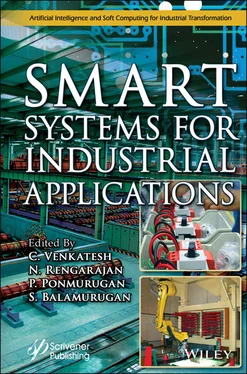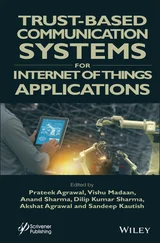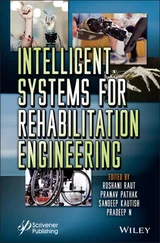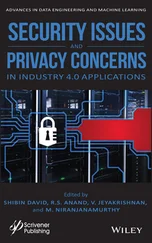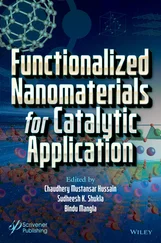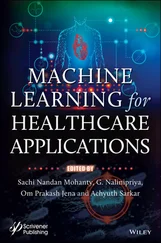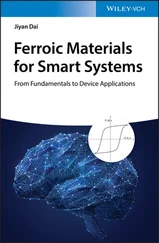Smart Systems for Industrial Applications
Здесь есть возможность читать онлайн «Smart Systems for Industrial Applications» — ознакомительный отрывок электронной книги совершенно бесплатно, а после прочтения отрывка купить полную версию. В некоторых случаях можно слушать аудио, скачать через торрент в формате fb2 и присутствует краткое содержание. Жанр: unrecognised, на английском языке. Описание произведения, (предисловие) а так же отзывы посетителей доступны на портале библиотеки ЛибКат.
- Название:Smart Systems for Industrial Applications
- Автор:
- Жанр:
- Год:неизвестен
- ISBN:нет данных
- Рейтинг книги:3 / 5. Голосов: 1
-
Избранное:Добавить в избранное
- Отзывы:
-
Ваша оценка:
- 60
- 1
- 2
- 3
- 4
- 5
Smart Systems for Industrial Applications: краткое содержание, описание и аннотация
Предлагаем к чтению аннотацию, описание, краткое содержание или предисловие (зависит от того, что написал сам автор книги «Smart Systems for Industrial Applications»). Если вы не нашли необходимую информацию о книге — напишите в комментариях, мы постараемся отыскать её.
The prime objective of this book is to provide an insight into the role and advancements of artificial intelligence in electrical systems and future challenges.
Audience
Smart Systems for Industrial Applications — читать онлайн ознакомительный отрывок
Ниже представлен текст книги, разбитый по страницам. Система сохранения места последней прочитанной страницы, позволяет с удобством читать онлайн бесплатно книгу «Smart Systems for Industrial Applications», без необходимости каждый раз заново искать на чём Вы остановились. Поставьте закладку, и сможете в любой момент перейти на страницу, на которой закончили чтение.
Интервал:
Закладка:
Printed in the USA
10 9 8 7 6 5 4 3 2 1
Preface
In this digital era, the towering intellectual abilities demonstrated by machines, known as artificial intelligence (AI), continue to advance innovations with the goal of improving the world. Artificial intelligence broadens horizons in the field of science, which will help change essential things and modulate eternal facts. This advancement in AI miraculously continues to retain an inspired vision in regards to emerging technologies. Hence, this book provides readers with the tools to fill in the AI-related knowledge gaps yet to be conquered through the use of smart intelligent systems for industrial applications.
Today, due to our subjugation to technology, there is much more to reckon within our quest for knowledge. Therefore, the knowledge included in the chapters of this book, which covers AI topics related to smart homes, smart cities, and smart towns, the industrial Internet of things, and smart earth and smart metering, will be helpful when confronting the most recent technological challenges in a timely manner.
In order to help the reader thrive in an AI world, the book covers a broad range of topics about AI from a multidisciplinary point of view, starting with its history and continuing on to theories about artificial vs. human intelligence, concepts and regulations concerning AI, human–machine distribution of power and control, delegation of decisions, the social and economic impact of AI, etc. The prominent role that AI plays in society by connecting people through technologies is highlighted in this book. It also covers key aspects of various AI applications in electrical systems in order to enable growth in electrical engineering. The impact that AI has on social and economic factors is also examined from various perspectives. Moreover, many intriguing aspects of AI techniques in different domains are covered such as e-learning, healthcare, smart grid, virtual assistance, etc. The contents of this book will be useful for students, teachers, and researchers who would like to know more about AI, which is a new technology that broadens the boundaries of learning in this contemporary world. Reading this book will be like taking a voyage through the land of AI.
Our sincere gratitude goes to all those who contributed to the valuable chapters of this book. Also, thanks go to the editorial director and the production editor at Scrivener Publishing, whose ardent support made the completion of this book possible.
Dr. C. VenkateshNamakkal, India Dr. N. RengarajanErode, India Dr. P. PonmuruganNamakkal, India Dr. S. BalamuruganCoimbatore, India October 2021
1
AI-Driven Information and Communication Technologies, Services, and Applications for Next-Generation Healthcare System
Vijayakumar Ponnusamy1*, A. Vasuki2, J. Christopher Clement3 and P. Eswaran4
1 ECE Department, SRM IST, Kattankulathur, Chennai, India 2 Department of Electronics and Communication Engineering, SRM Institute of Science and Technology, Vadapalani, Chennai, Tamil Nadu, India 3 School of Electronics Engineering, VIT, Vellore, India 4 ECE Department, SRM IST, Chennai, India
Abstract
Today, the introduction of communication technology has turned out an immense influence on healthcare. Communication technology enables real-time monitoring of a patient remotely to detect the health metrics and disease symptoms at an affordable price. Community-level health monitoring is also possible through these communication technologies, which saves time and enables us to serve more patients. Artificial Intelligence (AI)–based communication ensures reliable communication, which is a vital factor in the healthcare industry. AI with the Internet of Things (IoT) in healthcare makes self-diagnosing capability via wireless body area networks (WBANs), which uses wearable sensing devices. The wearable WBAN is a challenging one because it involves radiation of EM waves on the human body. mHealth is another technology that enables one to reach healthcare services anywhere at any time through the mobile application using specialized communication protocols. Augmented and virtual reality allows efficient diagnosis and does surgery using real-time digital visual aids with more precision. All those technologies require specialized wireless communication. Thus, this chapter intended to cover challenges, methodology, communication protocols, and applications of IoT-based healthcare, mHealth healthcare, body area networks, and augmented and virtual reality.
Keywords: Augmented reality, AI-driven communication, healthcare, Internet of Things, mHealth, wireless body area networks, virtual reality
1.1 Introduction: Overview of Communication Technology and Services for Healthcare
In recent days, communication technologies play a vital role in upcoming healthcare solutions. The drastic improvement in communication technologies, especially in the areas of wireless communication, offer anytime-anywhere connectivity to support advanced services for healthcare.
In our globe, the population is one of the main aspects to develop the most modernized technologies to reach the information as much as simple and easier to other people; most of the technologies have achieved its higher level to this advanced method by adopting those features. Uncertainly, some sectors are not utilizing the technology properly even though it helps mankind; the medical healthcare system is one of those. In the more regions of the world, the population is in denser growth and its impossible for a doctor or a specialized one to take care of every person they are examining and vice versa for patients also not able to reach doctors at a certain time [1], in these kinds of situations, eHealth is used to take care of these responsibilities. Together with the development of the internet, eHealth is one of the widely accepted healthcare services. It encompasses the applications of communication technologies for the support of healthcare activities. Telemedicine, telecare, clinical information networks, and analysis of heterogeneous data sources are the various branches of eHealth [2]. eHealthcare system design is illustrated in Figure 1.1.
This technology refers to Information and Communication Technologies (ICTs); these are the tools used by the healthcare professionals and also by the patients to diagnosis the health condition by themselves or with their relatives. It is a digitalized technology that supports capturing, storing, processing, and exchanging the information to provide the best healthcare support. The base principle of the ICT is to prevent and diagnosis the problem in an efficient way through digital technology; the ICT technology transformation in medical sectors are varied according to the platform. The wireless technology has emerged as a drastic one that can be unavoidable, so the smartphone technologies enable remote monitoring systems. These are used to avoid the condition of an emergency condition by detecting in initial conditions [1], so it is highly adopted. It refers to projects that allow the telehealth to promote patient-centered healthcare at a lower cost; the quality of the healthcare system is also more reliable in the technology. It enables a new way of communication between the doctors and the patients, to reduce the time for the patient to reach the doctor’s place.

Figure 1.1 eHealthcare system design.
Even though it has many advantages, the implementation of the ICT in practice is quite a complex one and requires a different level of changes by the healthcare providers and the healthcare organizations. It facilitates the sharing of data across the continuum of care across healthcare delivery organizations and different geographical areas. It mainly avoids unnecessary therapeutic interventions through the healthcare establishment and patient involvement.
Читать дальшеИнтервал:
Закладка:
Похожие книги на «Smart Systems for Industrial Applications»
Представляем Вашему вниманию похожие книги на «Smart Systems for Industrial Applications» списком для выбора. Мы отобрали схожую по названию и смыслу литературу в надежде предоставить читателям больше вариантов отыскать новые, интересные, ещё непрочитанные произведения.
Обсуждение, отзывы о книге «Smart Systems for Industrial Applications» и просто собственные мнения читателей. Оставьте ваши комментарии, напишите, что Вы думаете о произведении, его смысле или главных героях. Укажите что конкретно понравилось, а что нет, и почему Вы так считаете.
